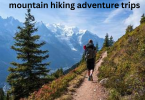If you’ve ever felt the urge to escape the daily routine, breathe in the fresh air, and experience nature in its raw form, then outdoor adventure travel might be exactly what you need. Whether it’s hiking across rugged trails, kayaking down untamed rivers, or camping under a starlit sky, planning your outdoor adventure travel plans carefully can turn a simple getaway into a life-changing experience.
This guide will walk you through everything you need to know — from choosing your adventure type and destination to understanding the benefits and potential challenges of outdoor adventure travel.
What Are Outdoor Adventure Travel Plans?

Outdoor adventure travel plans are well-thought-out arrangements made to experience nature and outdoor activities safely, efficiently, and enjoyably. These plans often include setting goals for your trip, selecting a destination, preparing gear, learning survival basics, and ensuring safety protocols are in place.
Unlike ordinary vacations, outdoor adventures are about stepping outside your comfort zone and connecting deeply with the natural world.
Why Outdoor Adventure Travel Is So Rewarding
There’s a unique satisfaction that comes from being surrounded by nature, away from screens, noise, and daily stress. Here’s why making outdoor adventure travel plans can be one of the most rewarding decisions you’ll ever make:
- Reconnection with Nature:
Being outdoors reminds you of life’s simplicity. The sights, sounds, and smells of nature help calm your mind and renew your perspective. - Physical Fitness:
Hiking, cycling, kayaking, or rock climbing naturally engage your body. These activities build endurance, improve strength, and keep you active without feeling like a workout. - Mental Clarity and Stress Relief:
Outdoor adventure travel helps reduce stress, anxiety, and fatigue. The combination of fresh air and physical activity boosts endorphins, which elevate mood and energy. - Personal Growth:
Overcoming challenges in the wild — whether it’s navigating a tricky path or setting up camp — boosts confidence and self-reliance. - Bonding and Social Connection:
Whether you travel with friends, family, or join a group of like-minded adventurers, shared experiences in nature often lead to lasting bonds and unforgettable memories.
Types of Outdoor Adventure Travel
The beauty of outdoor travel is that there’s something for everyone, regardless of experience level or physical ability. Here are some popular types of adventures to include in your plans:
- Hiking and Trekking: Great for beginners and nature enthusiasts who enjoy scenic landscapes and physical challenges.
- Camping: Ideal for those seeking peace, simplicity, and a chance to disconnect from technology.
- Kayaking or Rafting: Perfect if you love water-based activities and want a mix of relaxation and thrill.
- Cycling or Mountain Biking: Best for covering long distances while enjoying diverse terrain.
- Rock Climbing or Mountaineering: A more intense adventure that requires preparation and skill.
- Wildlife Safaris: Offers an opportunity to observe and photograph wild animals in their natural habitats.
How to Make Effective Outdoor Adventure Travel Plans
Planning ahead ensures your trip is enjoyable and safe. Here’s how to create a well-rounded plan:
1. Choose the Right Destination
Consider your goals, fitness level, and interests. For example, if you’re new to hiking, start with a national park or nearby nature reserve. If you’re an experienced adventurer, you might aim for the Andes, Himalayas, or the Rockies.
When researching, factor in the best time of year, climate conditions, and accessibility of the area.
2. Set a Realistic Budget
Outdoor adventures can be affordable, but costs vary depending on location, gear, and duration. Include expenses for transportation, permits, food, gear rental, and emergency funds.
3. Prepare the Right Gear
A successful adventure depends heavily on preparation. Essential gear typically includes:
- Weather-appropriate clothing
- Durable hiking boots or shoes
- Backpack with proper support
- Tent, sleeping bag, and sleeping mat (for camping trips)
- First-aid kit
- Portable stove or energy-rich food
- Navigation tools (map, compass, or GPS)
- Water filtration system
4. Check Local Regulations and Safety Guidelines
Before heading out, research local rules and safety measures. Some areas may require permits or limit visitor numbers to protect ecosystems.
5. Train and Condition Yourself
For physically demanding adventures, it’s important to prepare your body in advance. Basic strength and endurance training can make your experience much more enjoyable.
6. Create an Emergency Plan
Share your itinerary with someone you trust. Carry emergency contact information and learn basic first aid and navigation skills.
Benefits of Outdoor Adventure Travel
Outdoor adventure travel offers more than just excitement — it nurtures both body and soul. Here are its main benefits:
- Improved Physical Health: Regular exposure to outdoor activity enhances cardiovascular health and overall fitness.
- Better Mental Wellbeing: Nature-based travel has been proven to reduce symptoms of depression and anxiety.
- Enhanced Creativity and Focus: Spending time outdoors improves concentration and creative thinking.
- Environmental Awareness: Experiencing natural beauty firsthand fosters appreciation and responsibility toward the planet.
- Sense of Accomplishment: Completing a challenging adventure provides a confidence boost and sense of pride.
Drawbacks of Outdoor Adventure Travel

While outdoor adventure travel is fulfilling, it’s important to be aware of potential downsides so you can plan accordingly.
- Physical Demands:
Activities like hiking or climbing require stamina. Without preparation, fatigue or injury is possible. - Weather Unpredictability:
Sudden rain, heatwaves, or cold temperatures can disrupt plans and create risks. - Limited Comfort:
Outdoor travel often means minimal facilities — no cozy beds, limited showers, and basic meals. - Safety Risks:
Wildlife encounters, accidents, or getting lost are possible if safety measures aren’t followed. - Gear and Cost:
High-quality equipment can be expensive, especially for first-timers.
Despite these challenges, most drawbacks can be managed with thoughtful planning, proper gear, and realistic expectations.
You may also like to read these posts:
Travel Guide for Beginners: Your Complete Step-by-Step Guide to Starting Your Journey
Best Travel Guides 2026: Your Complete Companion for Smarter and More Meaningful Travel
Europe Travel Guide for Tourists: Everything You Need to Know Before Exploring the Continent
Asia Travel Guide for Visitors: A Complete and Friendly Guide to Exploring the Continent
Tips for a Successful Outdoor Adventure Trip
- Start small and gradually take on more challenging adventures.
- Respect the environment — always follow Leave No Trace principles.
- Travel with companions, especially if you’re new to outdoor travel.
- Stay hydrated and pace yourself.
- Embrace flexibility — not everything will go exactly as planned.
Final Thoughts
Creating your outdoor adventure travel plans is about more than logistics — it’s about designing an experience that recharges your spirit and challenges your limits. While there may be obstacles, the rewards far outweigh them.
Every trail, every sunrise, and every quiet moment in nature brings a sense of peace and purpose that’s hard to find elsewhere. So take that step, plan your next outdoor journey, and discover the world beyond your comfort zone.
Your adventure begins the moment you start planning.
FAQs
1. What are outdoor adventure travel plans?
Outdoor adventure travel plans refer to the process of organizing a trip that involves physical activities in natural environments — such as hiking, camping, climbing, or kayaking. These plans include choosing a destination, preparing gear, budgeting, ensuring safety, and setting travel goals.
2. Why should I make a detailed outdoor adventure travel plan?
Planning in advance helps you avoid unnecessary stress and ensures safety. A detailed plan allows you to prepare the right equipment, research weather conditions, understand local rules, and make the most of your time outdoors.
3. What are the best destinations for outdoor adventure travel?
It depends on your interests and skill level. Some popular options include:
National Parks for hiking and camping
Mountain regions like the Rockies, Alps, or Andes for trekking and climbing
Coastal areas for kayaking, snorkeling, or surfing
Forests and deserts for solitude and exploration
4. What should I pack for an outdoor adventure trip?
Essential items include weather-appropriate clothing, sturdy footwear, navigation tools, a first aid kit, a tent or shelter, food and water supplies, and safety gear. Always pack light but smart — carry only what’s necessary for your safety and comfort.
5. How do I stay safe during an outdoor adventure?
Safety should be your top priority. Here are a few key tips:
Always inform someone about your travel route and expected return.
Check weather forecasts before departure
Carry a first-aid kit and know basic survival techniques.
Stay hydrated and well-nourished.
Respect wildlife and avoid taking unnecessary risks





